The Economics and Statistics Division maintains archives of previous publications for accountability purposes, but makes no updates to keep these documents current with the latest data revisions from Statistics Canada. As a result, information in older documents may not be accurate. Please exercise caution when referring to older documents. For the latest information and historical data, please contact the individual listed to the right.
<--- Return to Archive
For additional information relating to this article, please contact:
January 13, 2022NOVA SCOTIA POPULATION ESTIMATES BY COUNTY AND CENSUS SUBDIVISION - JULY 1, 2021 Statistics Canada has released estimates of the population by county as of July 1, 2021. Provincial population estimates for July 1, 2021 were released on September 29, 2021 and updated to October 1, 2021 on December 16, 2021. These population estimates should not be confused with Census counts. Estimates of the population adjust for net undercoverage from the Census as well as incompletely enumerated Indian reserves. The current estimates are based on the results of the 2016 Census of the population and data back to 2006 have been revised.
In Nova Scotia, 16 of the 18 counties had population growth from July 1, 2020 to July 1, 2021. Halifax had the fastest growth at 2.1%, followed by Annapolis at 1.3%. There was also population growth in Yarmouth, Digby, Queens, Lunenburg, Kings, Hants, Colchester, Cumberland, Pictou, Antigonish, Inverness, Richmond, and Victoria counties. Population declined in Cape Breton (-1.7%) and Shelbourne (-0.6%). Population in Guysborough remained effectively unchanged (+3) from the previous year.
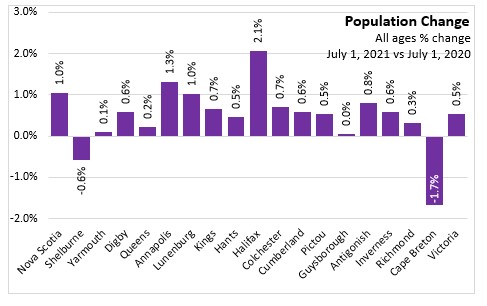
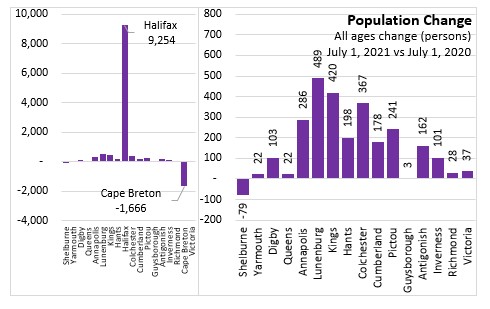
Halifax's population has risen to 460,232 or 46.4% of the provincial population. Cape Breton county's population was 98,635 as of July 1st 2021 and had 9.9% of the provincial population. The other three counties on Cape Breton Island (Inverness, Richmond and Victoria) accounted for 3.4% of the provincial population (33,600). Counties in the North Shore economic region (Colchester, Cumberland, Pictou, Guysborough, and Antigonish) had a population of 154,866 or 15.6% of the provincial total. Counties in the Annapolis Valley (Annapolis, Kings and Hants) had 129,269 residents or 13.0% of Nova Scotia's population. The counties of Southern Nova Scotia (Shelburne, Yarmouth, Digby, Queens and Lunenburg) had a population of 115,453 or 11.6% of the provincial total.
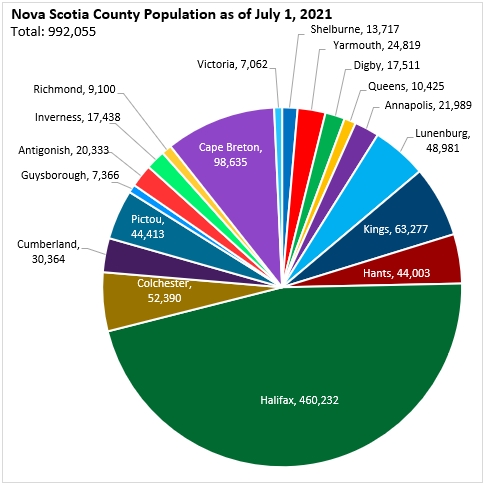
Note: scales for all counties are set to 7,000 except Cape Breton (21,000) and Halifax (140,000).
Following four years of accelerating population growth, Nova Scotia’s population growth decelerated to 1.0% in 2021. Much of the growth in 2021 has been attributable to ongoing increases in the population of Halifax, Lunenburg, Kings,Colchester and Annapolis. Population has rebounded in Yarmouth, Digby, Inverness, Richmond and Victoria. Shelburne and Cape Breton registered declines in their populations in 2021.
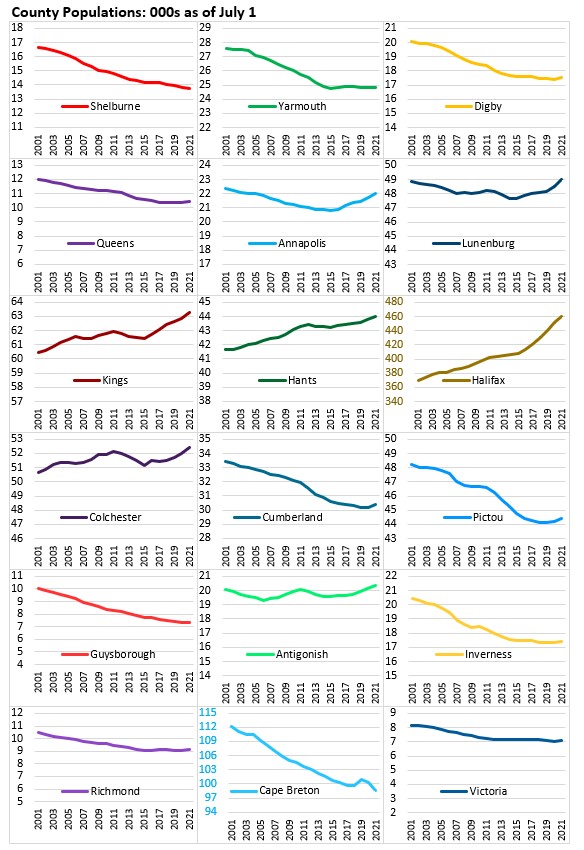
Components of county population change
Population estimates for counties change from one year to the next based on natural change (births, deaths), international migration (immigration, emigration, non-permanent residents), interprovincial migration (from one province to another) and intraprovincial migration (from one county of the province to another).
All counties except Halifax reported more deaths than births between July 1, 2020 and July 1, 2021. The natural population decline was largest in Cape Breton (-658) and smallest in Richmond county (-44). Halifax had a natural increase of 468.
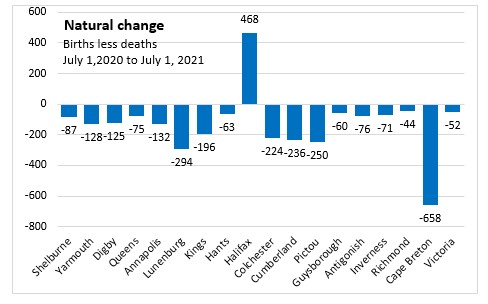
Immigration continued to support Nova Scotia's population growth, but at a slower pace because of pandemic-related border restrictions. Immigration was concentrated in Halifax with 2,840 immigrants added to the population. The next highest numbers of immigrants added were in Colchester, Kings and Cape Breton counties.
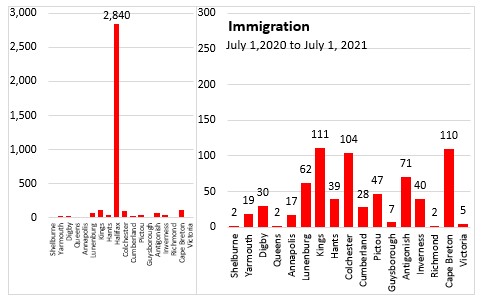
Increases in the number of non-permanent residents had been a significant source of population growth for some counties (notably Cape Breton) before the pandemic-related border restrictions were imposed. Net change in the number of non-permanent residents was highest in Pictou County (+104) from July 1, 2020 to July 1, 2021. Cape Breton County had a decline of 838.
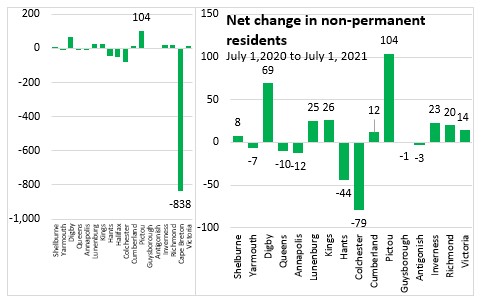
Overall net international migration (including immigration, net non-permanent residents, less emigration) contributed to population growth in every county except Queens and Hants. Net international migration was concentrated in Halifax (+2,598) while net international migration declined in Cape Breton to -728.
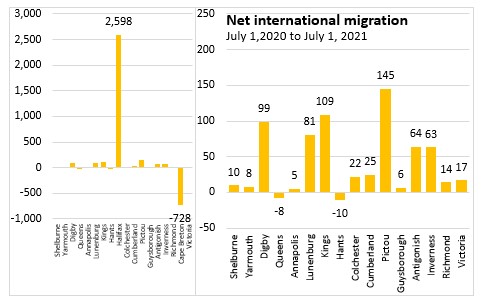
Net interprovincial migration (in-migrants less out-migrants) played an important role in Nova Scotia’s population growth in 2021. Net interprovincial migration was concentrated in Halifax with a net gain of 5,594 persons, but all counties reported positive net interprovincial migration in the last year.
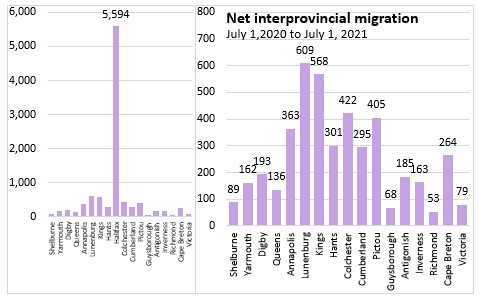
Net movements within the province have contributed to population increases in Halifax, Colchester, Cumberland, Annapolis, Richmond and Lunenburg counties. All other counties had net negative migration with the rest of the province. Cape Breton County had the largest net intraprovincial outmigration (-544).
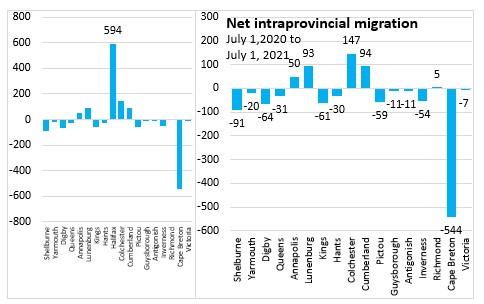
Age cohorts
Looking at the distribution of population across age groups and sexes, Nova Scotia’s population is concentrated in the 50 to 70-year-old age cohort. The distribution is similar between males and females.
Halifax has a higher share of population between the ages of 20 to 40 compared to Nova Scotia among both males and females. The share of population aged 50 and higher is lower compared to the provincial average.
The counties of Yarmouth, Kings, Hants, Colchester, Pictou and Antigonish have population distribution similar to the provincial average.
Compared to the provincial average, a higher share of population in the 50 to 70 year old cohort was living in the Shelbourne, Digby, Queens, Annapolis, Lunenburg, Cumberland, Guysborough, Inverness, Richmond, Cape Breton, and Victoria counties. The share of population between 20 to 40-year-old cohort was lower than the provincial average in these counties.
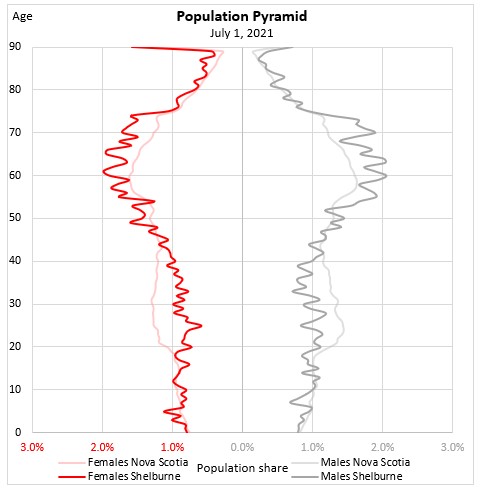
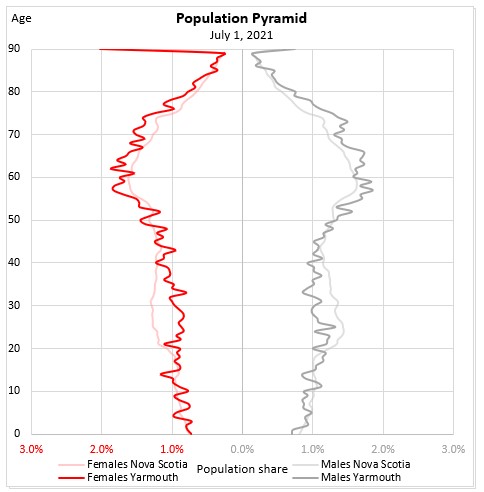
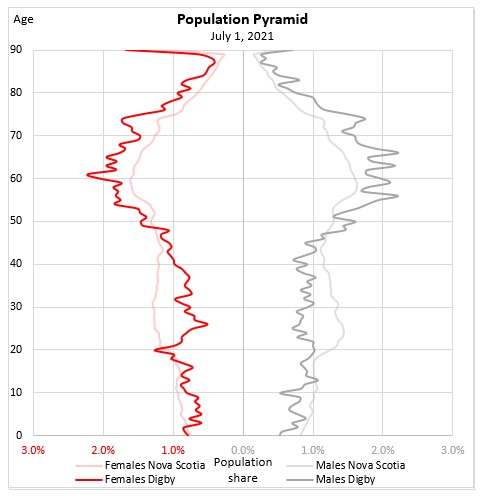
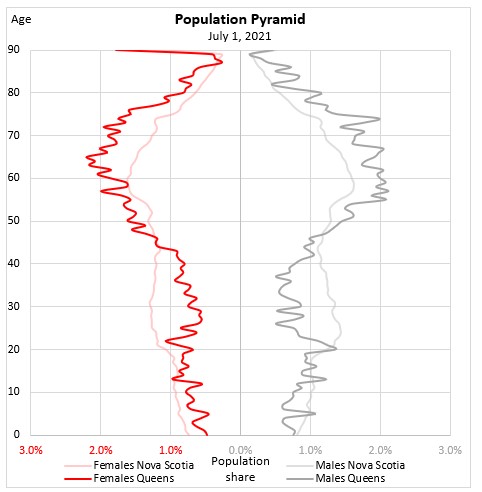
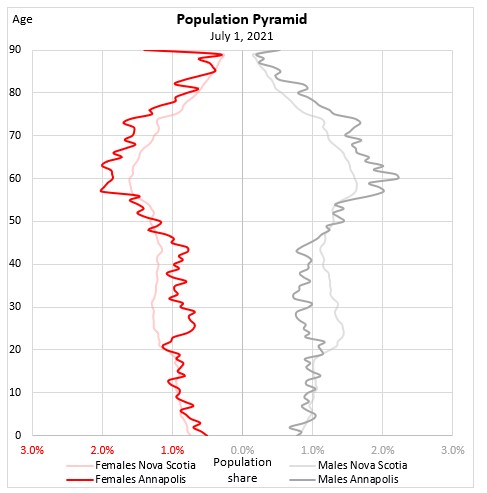

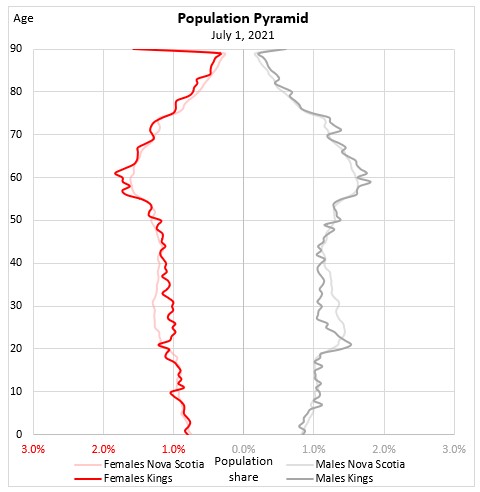
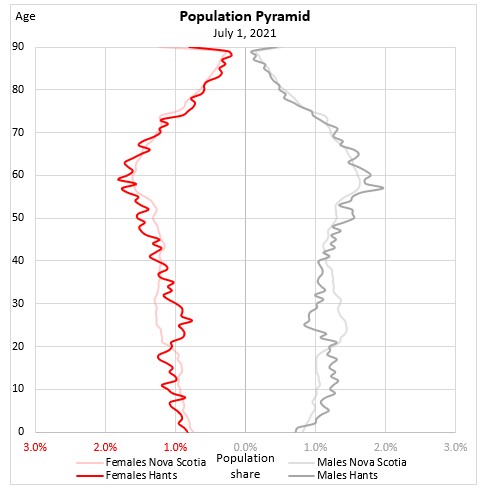
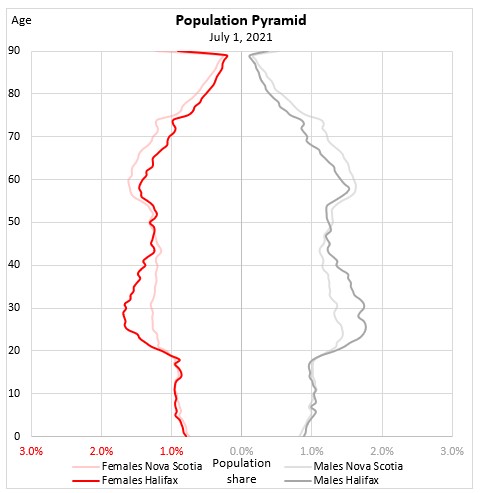
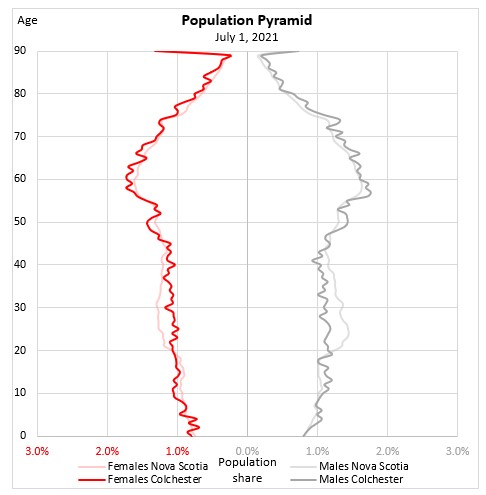
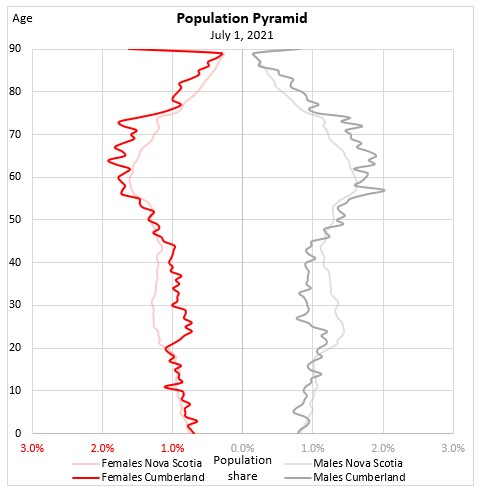

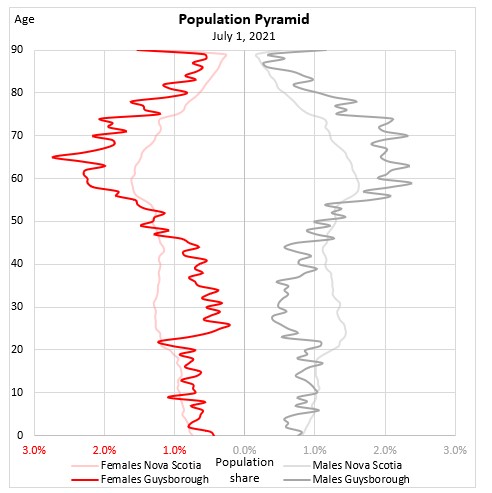
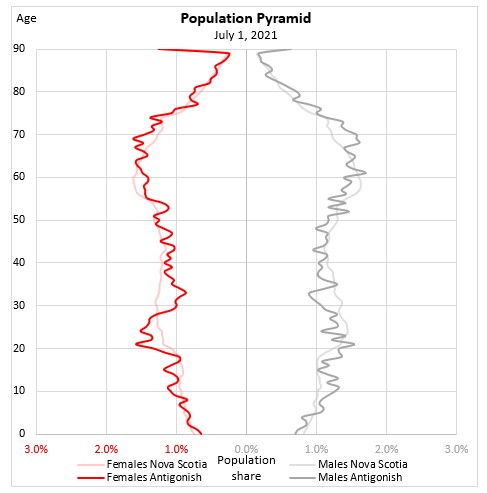
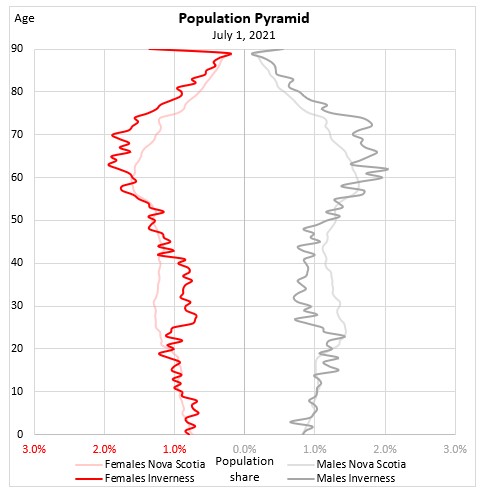


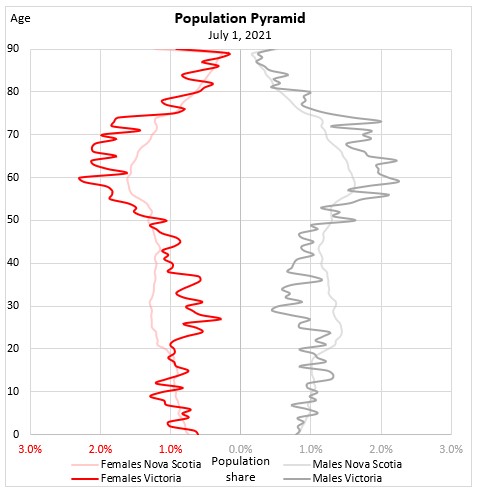
Nova Scotia's median age increased slightly from 44.9 on July 1, 2020 to 45.0 in July 1, 2021. The median age was stable or up in all counties over the last year. Halifax has the lowest median age at 39.8 years while the highest median age was observed in Guysborough County at 58.4 years.
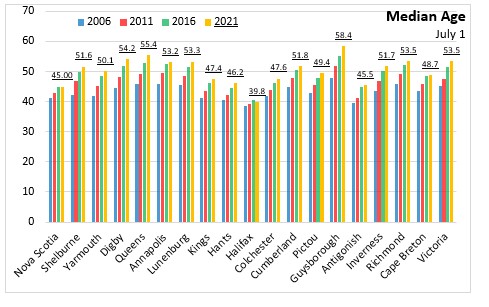
Cities
Population growth was faster in urban areas from July 1, 2020 to July 1, 2021. Halifax's population growth of 2.1% was the third fastest among Census Metropolitan Areas (CMAs) after Kelowna, British Columbia and Oshawa, Ontario. Population growth in Nova Scotia outside the Halifax CMA was 0.2%.
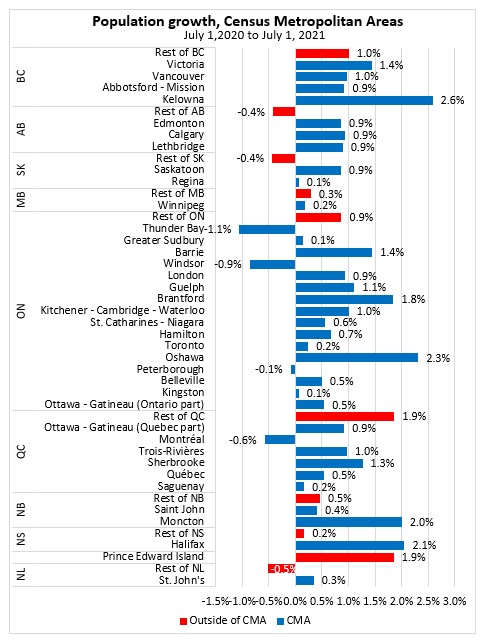
Census Subdivisions
With release of July 1, 2019 population estimates, Statistics Canada has now made population estimates available for Census Subdivisions as well as Census Divisions (counties). Census subdivisions are towns, municipal districts, regional municipalities, Indian reserves and rural areas (identified as Subdivisions A, B, C, or D in their counties). A map of Nova Scotia's census subdivisions can be found here: Standard Geographical Classification, census division – census subdivision maps, Nova Scotia (PDF version, 4369.7 KB)
Note: all county scales are set to a range of 7,000 (except Halifax and Cape Breton). All census subdivision scales are set to a range of 1,500 (except Halifax Regional Municipality and Cape Breton Regional Municipality).
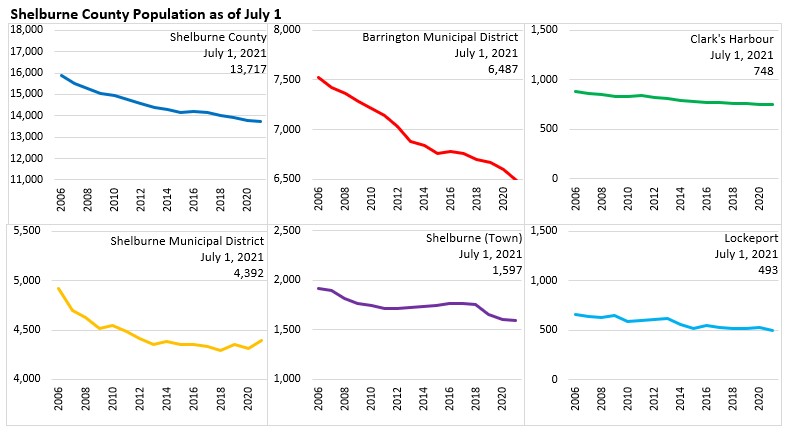

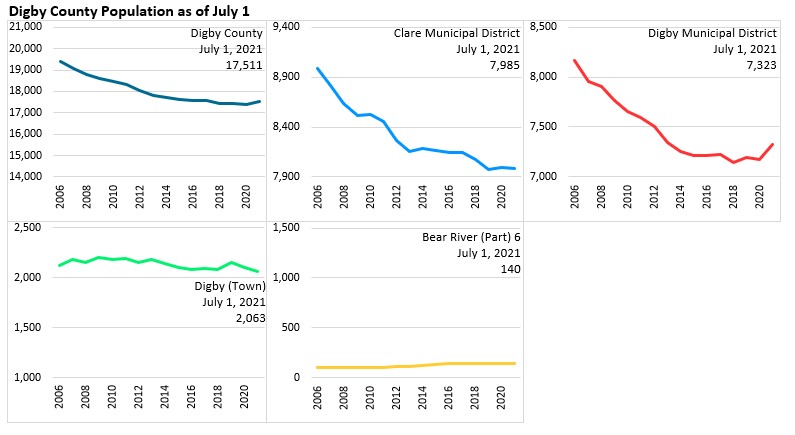
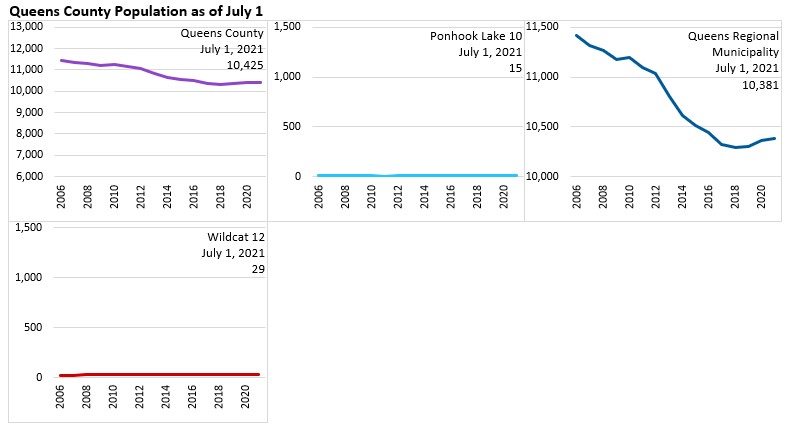
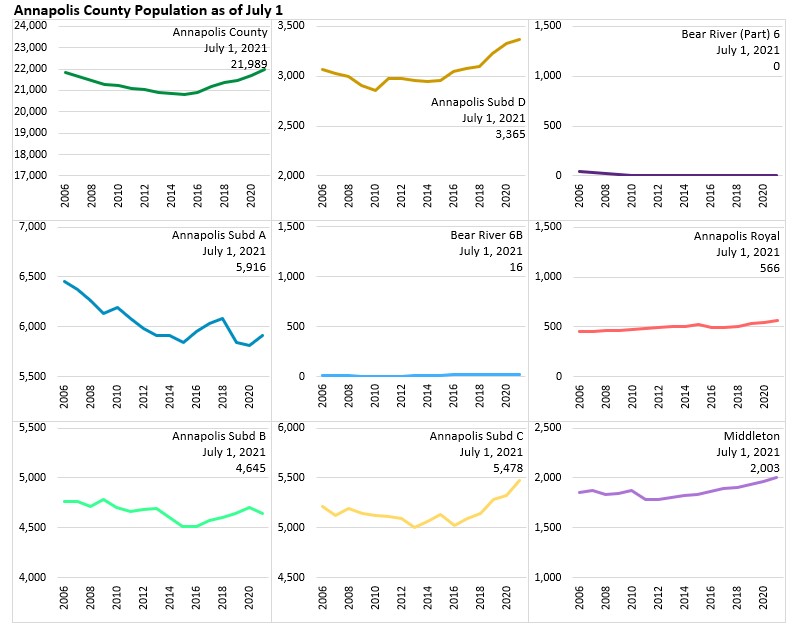

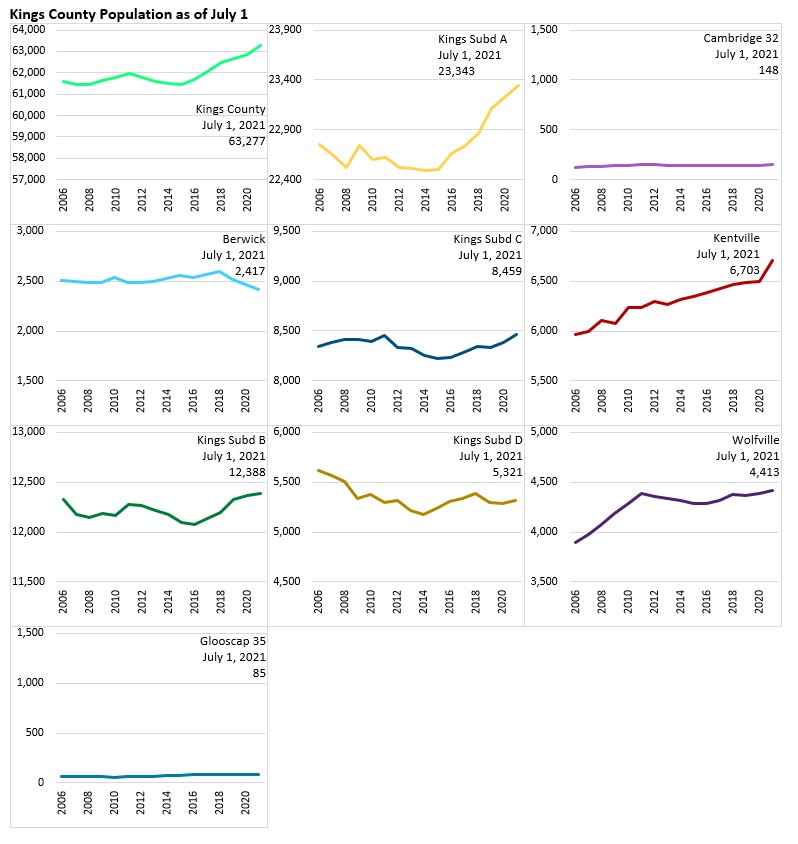
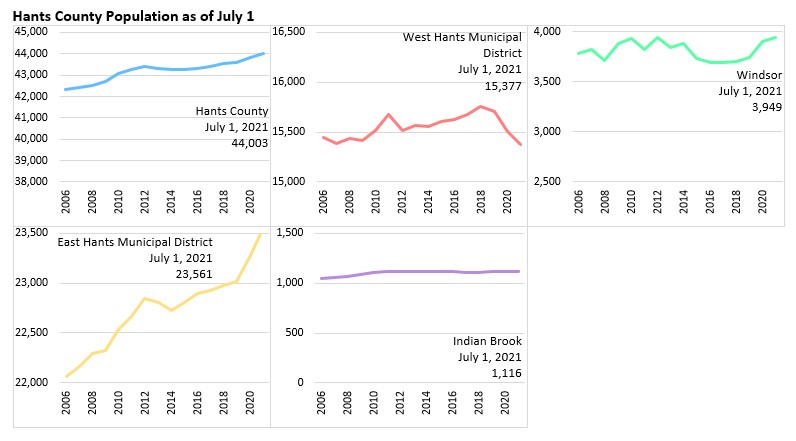

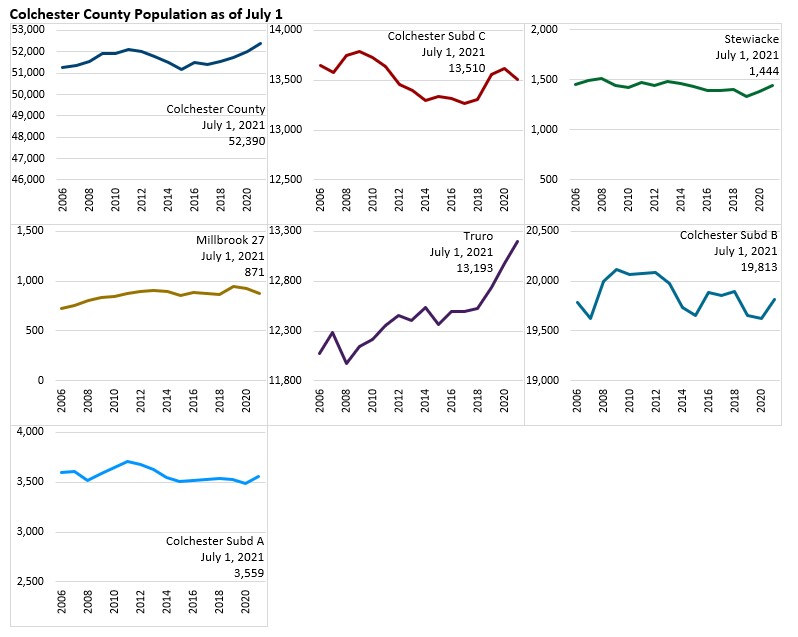
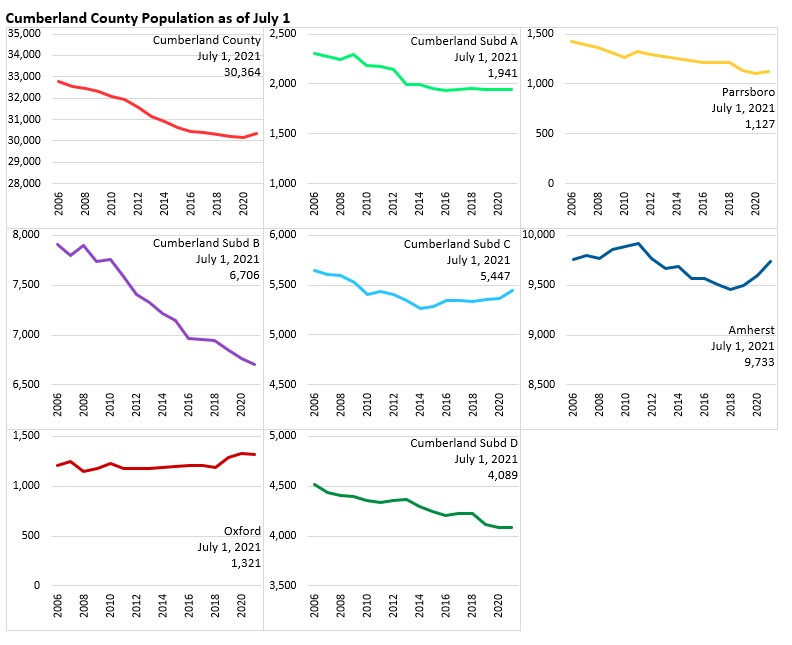
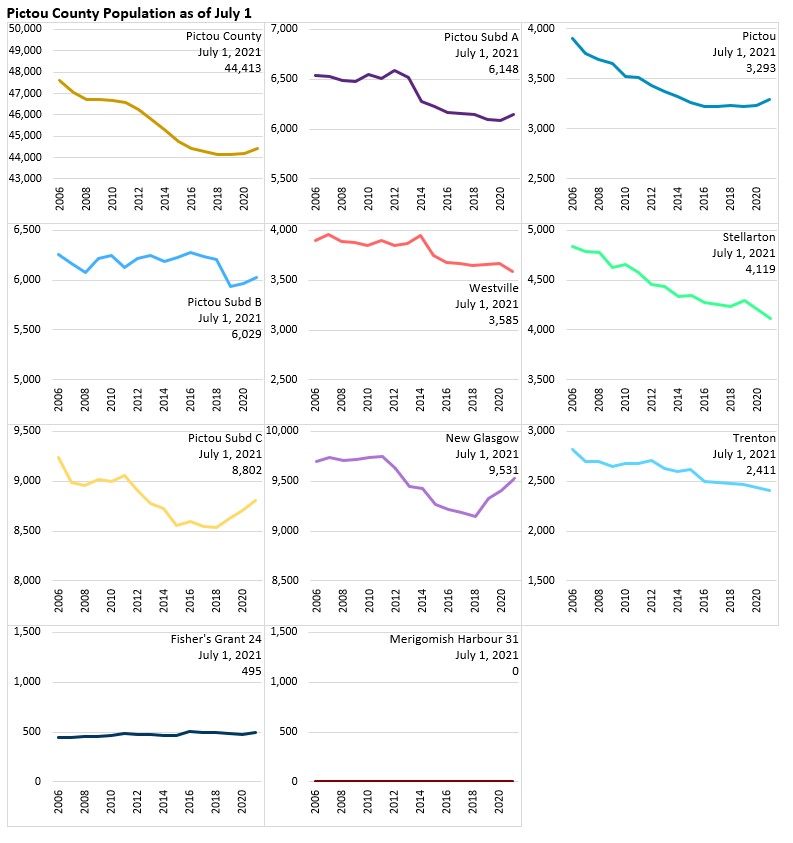
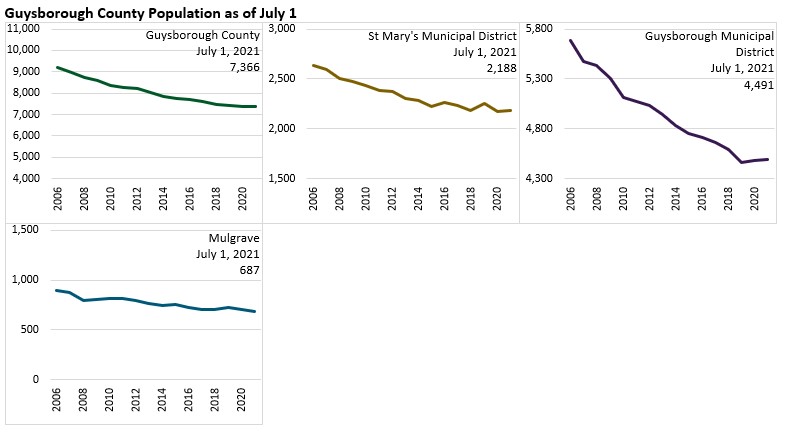
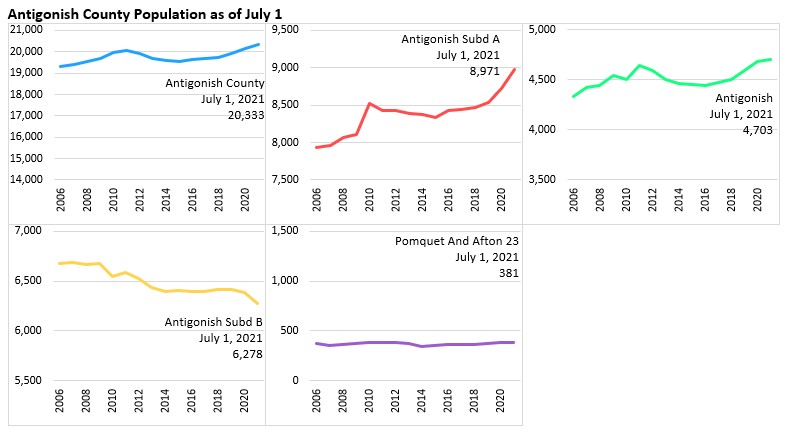
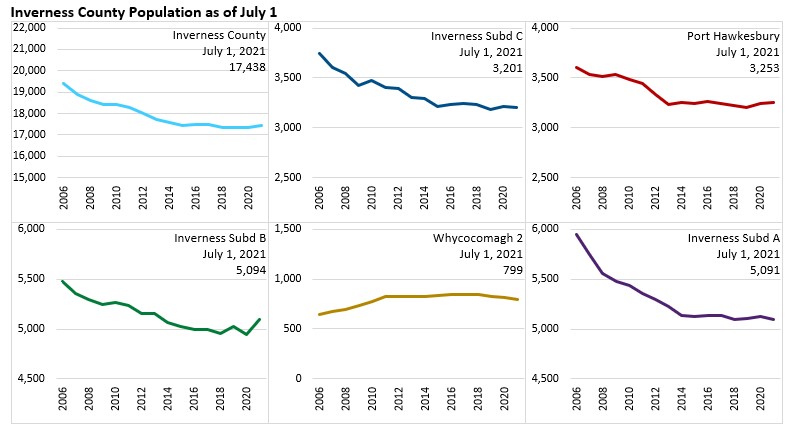
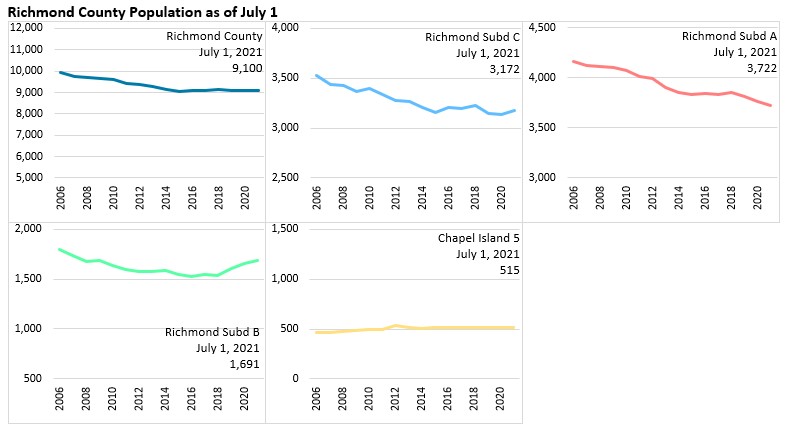
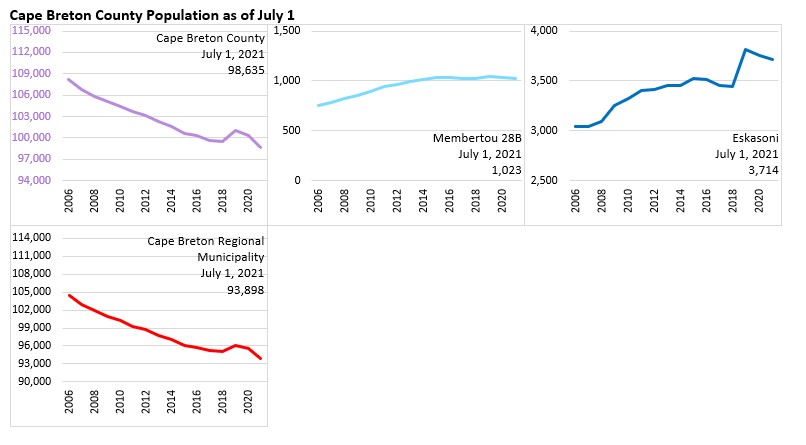
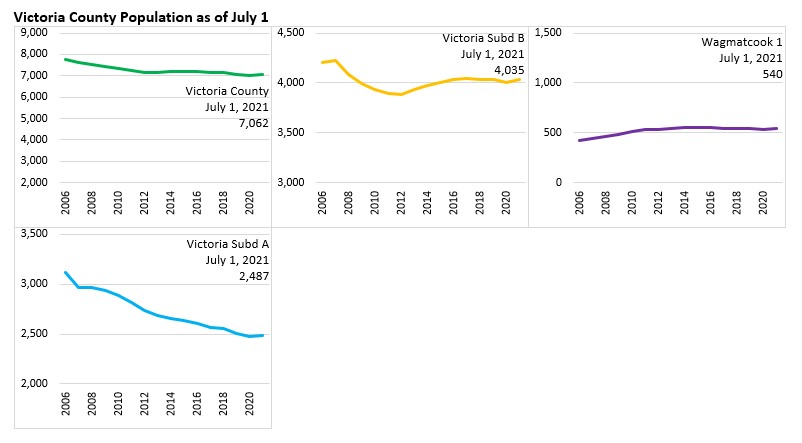
Sources: Statistics Canada. Table 17-10-0135-01 Population estimates, July 1, by census metropolitan area and census agglomeration, 2016 boundaries; Table 17-10-0139-01 Population estimates, July 1, by census division, 2016 boundaries; Table 17-10-0140-01 Components of population change by census division, 2016 boundaries; Table 17-10-0142-01 Population estimates, July 1, by census subdivision, 2016 boundaries; Standard Geographical Classification, census division – census subdivision maps, Nova Scotia (PDF version, 4369.7 KB)
<--- Return to Archive